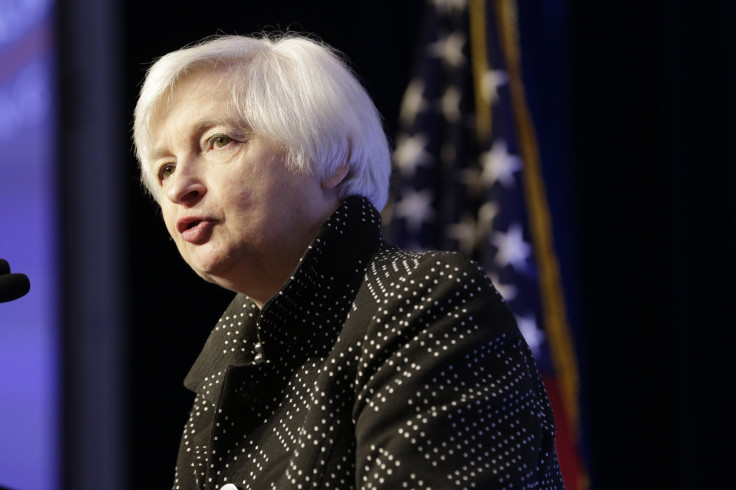Yellen 'Looking Forward' To Interest Rate Hike As Fed Mulls December Liftoff

Federal Reserve Chair Janet Yellen laid the groundwork for a modestly optimistic view of the nation's economy and, thus, a basis for a benchmark interest rate hike this month. Such a move would mark the first such increase in almost a decade, something that has been anticipated for months.
“It is a day that I expect we all are looking forward to,” she said Wednesday in prepared remarks at the Economic Club of Washington.
Even as she spoke optimistically on economic growth and labor conditions, however, Yellen gave no further clues as to whether the stars have aligned for a rate hike from the U.S. central bank's Federal Open Markets Committee this month, emphasizing the fact that interest rates should remain below historical averages for the foreseeable future.
“Economic conditions may, for some time, warrant keeping the target federal funds rate below levels the committee views as normal in the longer run,” Yellen said.
Earlier on Wednesday, Atlanta Fed President Dennis Lockhart spoke in Fort Lauderdale, Florida, expressing muted confidence that conditions will cohere around a December rate hike. “Absent information that drastically changes the economic picture and outlook, I feel the case for liftoff is compelling,” said Lockhart, who noted that economic data in the coming two weeks could still affect his outlook.
Conflicting Signals
The comments came amid a week that has seen economic signals flash in opposite directions. On the positive side, payroll administrator ADP reported that U.S. employers added 217,000 jobs in November, exceeding economists’ expectations of 190,000, with growing momentum in professional services hiring.
“Job growth remains strong and steady,” said Mark Zandi, chief economist at Moody’s Analytics. The most recent headline unemployment rate came in at an even 5 percent, approaching levels the Fed considers healthy. “The economy is fast approaching full employment,” Zandi said.
Earlier in the week, however, the manufacturing sector laid an egg. Factory activity for November fell to a reading not seen since June 2009, the last month of the Great Recession. The manufacturing gauge, maintained by the Institute for Supply Management, has fallen into negative territory only once since then, in November 2012.
Economists put the blame for weak manufacturing on a combination of a strong dollar and flagging economic growth in China and Europe. Those two factors have dealt exports a one-two punch, even as consumer spending dipped in October. A more expensive dollar dampens the appetite for American goods abroad.
In total, the economic data don’t inspire great confidence in a December liftoff, Steven Ricchiuto, chief economist of Mizuho Securities, said. “The bulk of the economic data, which has been on the weak side, will weigh more heavily than the employment numbers.”
The outlook is further hampered by conditions abroad. Inflation has failed to materialize in Japan and the eurozone, both of which are expected to pursue more monetary easing through central bank asset purchases and continued low interest rates. The result: an even stronger dollar. “All those things add up to the Federal Reserve not doing much,” Ricchiuto said.
Yellen, however, sounded optimistic that the headwinds would subside. “The drag from some of the factors that have been weighing on economic growth should begin to lessen next year,” she said.
Also on Wednesday, the Fed reported a "modest pace" in economic growth in its semiregular analysis of the American economy known as the Beige Book. The report said that labor markets in general continued to "tighten modestly," although most of the Fed's 12 districts saw significant upward wage pressures only for skilled employees and those in high demand.
Dollar Risks
Wall Street may be leaning toward Yellen's view rather than Ricchiuto's. Futures meant to hedge against benchmark interest rate changes imply a 75 percent probability that the Fed will announce a rate hike Dec. 16. In the minutes from the rate-setting committee’s last meeting in October, Fed officials agreed “conditions could well be met by the time of the next meeting” to raise rates.
But headwinds abroad could stymie those expectations. Lockhart said that he would be watching exchange rates in the coming weeks. “I am treating a further rise in the dollar as a risk to my outlook,” Lockhart said.
The Federal Reserve has a dual mandate to maximize employment while guarding against rising inflation. In March, the Fed said that it would be on the lookout for “further improvement” in labor conditions and “reasonable confidence” that inflation would solidify around the target rate of 2 percent.
Core inflation, which excludes volatile food and energy prices, has undershot Fed expectations for 42 straight months. The yearlong plunge in oil prices has contributed to muted inflation readings, a development that Yellen saw reversing in the coming year. “The drag from the large declines in prices for crude oil and imports over the past year and a half will diminish next year,” Yellen said.
Markets have been just as interested in how soon a liftoff will occur as in how quickly the Fed will pull rates back up. Fed officials have been largely unanimous in suggesting a measured approach. Chicago Fed President Charles Evans said it was “vital” that the committee “strongly and effectively communicates its plan for a gradual path for future rate increases.”
Yellen tried to assure markets that the Fed intends to preempt runaway inflation so that no sudden moves become necessary, noting that “an abrupt tightening would risk disrupting financial markets and perhaps even inadvertently push the economy into recession.”
© Copyright IBTimes 2024. All rights reserved.




















